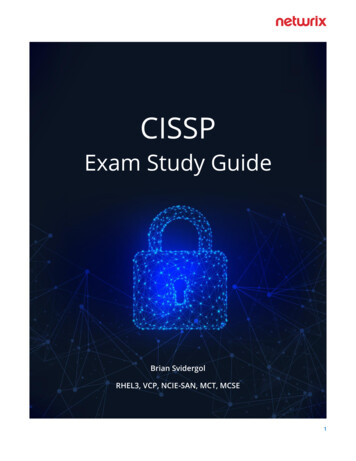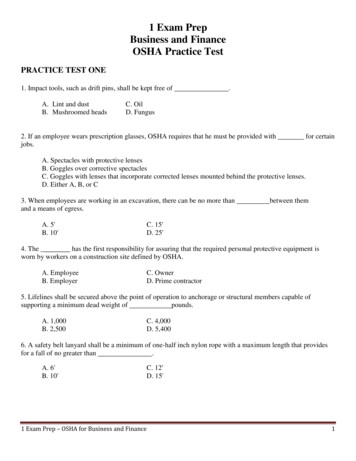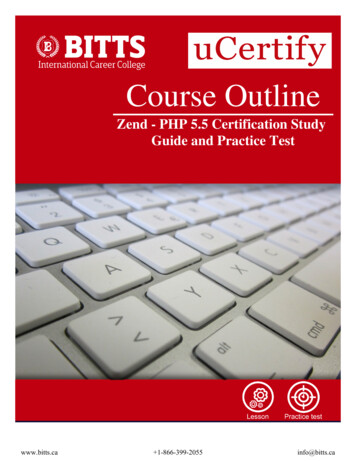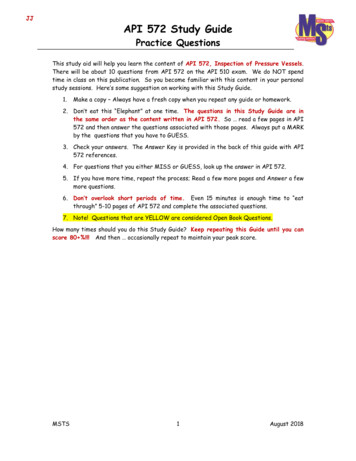
Transcription
THE STUDY ANDPRACTICE OF YOGAAN EXPOSITION OF THE YOGASUTRAS OF PATANJALIVOLUME I – SAMADHI PADASWAMI KRISHNANANDAThe Divine Life SocietySivananda Ashram, Rishikesh, IndiaWebsite: www.swami-krishnananda.org
ABOUT THIS EDITIONThough this eBook edition is designed primarily fordigital readers and computers, it works well for print too.Page size dimensions are 5.5" x 8.5", or half a regular sizesheet, and can be printed for personal, non-commercialuse: two pages to one side of a sheet by adjusting yourprinter settings.2
CONTENTSAbout this Edition . 2Publisher’s Note . 5Chapter 1: The Aim of Yoga . 7Chapter 2: The Foundation of the Discipline in YogaPractice . 17Chapter 3: Broad Outline of the Stages of Yoga . 28Chapter 4: Individuality and Consciousness . 39Chapter 5: The Practice of Being Alone . 52Chapter 6: Spiritual Life Is Postive, Not Punitive . 64Chapter 7: Initial Steps in Yoga Practice . 77Chapter 8: The Principle of Self-Affirmation. 89Chapter 9: Perception and Reality. 100Chapter 10: Self-Control: The Alpha and Omega of Yoga. 112Chapter 11: The Integrality of the Higher Self. 125Chapter 12: Sublimation – A Way To Reshuffle Thought. 135Chapter 13: Defence Mechanisms of the Mind . 148Chapter 14: The Indivisibility of All Things . 160Chapter 15: Consonance With the Essential Make-Up ofThings . 172Chapter 16: The Inseprability of Notions and the Mind . 184Chapter 17: Objectivity Is Experience Finally . 195Chapter 18: The Dual Process of Withdrawal andContemplation . 207Chapter 19: Returning To Pure Subjectivity . 220Chapter 20: The World and Our World . 231Chapter 21: Returning To Our True Nature . 244Chapter 23: The Internal Relationship of All Things . 270Chapter 24: Affiliation With Larger Wholes . 286Chapter 25: Sadhana – Intensifying A Lighted Flame. 298Chapter 26: The Gunas of Prakriti . 309Chapter 27: Problems Are A State of Mind . 323Chapter 28: Bringing About Whole-Souled Dedication . 3353
Chapter 29: The Play of the Gunas . 348Chapter 30: The Cause of Bondage. 361Chapter 31: Intense Aspiration. 373Chapter 32: Our Concept of God . 387Chapter 33: What Divine Love Is. 399Chapter 34: Surrender To God . 414Chapter 35: Yhe Recitation of Mantra . 426Chapter 36: The Rise of Obstacles in Yoga Practice . 437Chapter 37: Preventing the Fall in Yoga. 450Chapter 38: Impediments in Concentration andMeditation . 463Chapter 39: Concentrating the Mind On One Reality . 476Chapter 40: Re-Educating the Mind. 490Chapter 41: Becoming Harmonious With All . 504Chapter 42: How Feelings and Sensation Work . 517Chapter 43: Harmonising Subject and Object . 530Chapter 44: Assimilating the Object . 544Chapter 45: Piercing the Structure of the Object . 555Chapter 46: The Barrier of Space and Time . 567Chapter 47: The Rise From Savitarka To Nirvitarka. 579Chapter 48: Encountering Troubles and Opposition. 593Chapter 49: The Rise To Savichara and Nirvichara. 604Chapter 50: The States of Sananda and Sasmita. 616Chapter 51: Sat-Chit-Ananda Or God-Consciousness . 6284
PUBLISHER’S NOTEThis is a compilation of the 110 lectures that SwamiKrishnananda delivered from March to August in 1976 onthe Yoga Sutras of Patanjali. Patanjali’s Yoga Sutras are amanual on mind control, meditation and mentaldiscipline—a manual for spiritual freedom. Crisp and pithyin rendition, the sutras have an aphoristic quality and urgedeeper reflection and dedicated application.Across various philosophies the denotation of yogavaries. Patanjali uses the term ‘yoga’ to denote a completecessation of mental modifications so that consciousnessrests within itself in the state of moksha or liberation. Thisteaching has been delivered through emphasis on practicerather than mere philosophy. This is verily a manual for usto operate the mind and thus our life.The Yoga Sutras are divided into four padas orchapters. The first chapter, the Samadhi Pada on whichthis volume is based, focuses on concentration of the mindand the practical aspects necessary for attaining meditativeabsorption. The second chapter, the Sadhana Pada, is aboutattaining and holding that single-pointedness throughreining in the agitations of the mind by cultivatingdispassion, discrimination and dedication. The thirdchapter, the Vibhuti Pada, focuses on the technique ofsamyama which is the combination of concentration,meditation and communion for the liberation of the spirit,while the fourth chapter, the Kaivalya Pada, is ametaphysical disquisition which deals with various subjects5
as a sort of explanation of some of the themes dealt with inthe earlier chapters.It is fitting to draw the reader’s attention to the clarityand simplicity with which Swamiji Maharaj comments onthese sutras. Swami Krishnananda was the livingembodiment of that awareness to which the sutras and allspiritual texts guide. It is commonly said that Sanskrit, thelanguage of the Gods, is by far the only one that hastranscended, to some extent, the limitations of vividexpression and bears in it the ability to express the nuancesof spiritual processes and the resultant experiences that thegreat Sages and Masters have experienced and conveyed tous. That Swamiji Maharaj is able to bend the limitedEnglish language to yield to his knowledge is a completelyhumbling experience.These Yoga Sutras of Patanjali spoken by SwamiKrishnananda are being made available to the public for thefirst time. It is our desire to retain the original lectures intheir spoken form to a large extent. The are some uniquetwists of phrases and application of words that are uniquelySwamiji in origin and it has been sought to allow those tobe as they were intended, without undermining thereverence to the English language. Consequently thelectures have been edited in very few places to render themthe way Swamiji Maharaj himself spoke them.6
Chapter 1THE AIM OF YOGAThe whole of our life is a successive series of efforts –whether it is the effort that I put forth, or that whichsomeone else puts forth. All these efforts have a commonbackground, although the efforts of human beings arevariegated and there is also an apparent diversity of theaims behind the efforts. The farmer’s effort is towardsproducing harvest in the field; the industrialist’s effort istowards production of goods and such other items in hisfield; the effort of the schoolmaster or the professor is inanother direction; and so on and so forth. We have anapparent diversity of aims, motivated by a diversity ofefforts.But this is a great illusion that is before us, and we livein a world of illusions which we mistake for realities. Theillusion arises on account of our inability to see beyond acertain limit of the horizon of our mental perceptions. Thefarmer forgets that the production of the harvest in the fieldis not the only aim, or rather the ultimate aim, of his efforts.It has another aim altogether connected with certain others,and so on and so forth, in an endless chain which cannoteasily come within the comprehension of an untutoredmind. The stomach does not eat for its satisfaction. Weknow very well why the stomach eats. The stomach may say“I eat”, but it does not eat; the eater is somebody else,though it is thrust into the stomach. The legs do not walkfor their own sake. What do the legs gain by walking? Theyare walking for some other purpose – somebody else’s7
purpose, not their own. Nor do the eyes gain anything byseeing; the eyes see for somebody else.Likewise, there is an inherent and underlying basic aimwhich is transcendent to the immediate purpose visible infront of any particular individual who puts forth effort, justas the legs do not walk for their own sake, the eyes do notsee for their own sake, the stomach does not eat for its ownsake, and so on, and they seem to be functioning for someother purpose. They can miss this purpose, and then thereis what we call dismemberment or disintegration of thepersonality. When the aim is missed, the effort loses itsmotive power and it becomes a fruitless effort, because aneffort that has missed its aim cannot be regarded as ameaningful effort. Also, it may be possible that we may beconscious of an immediate aim before the effort, but theaims that are further behind or ahead may not be visible toour eyes.I will ask a question. We eat food every day so that wemay be alive. But why do we want to be alive? Is there apurpose behind it? This question we cannot answer. Here isa question which is beyond ordinary logic. Why should wework so hard, and eat, and maintain ourselves, and exist?After all, we are doing all this for existing. Why do we wantto exist? Suppose we do not exist; what is the harm? Thesekinds of questions will be pressing themselves forwardwhen we go deep into the aims of the different activities ofour life. Finally, when we press the aim to its logical limits,we will find that the human brain is not meant tounderstand it.We are limited individuals, with limited capacities ofunderstanding, and we can have only limited aims in our8
life – but we have unlimited desires. This is a contradiction.How can unlimited desires be fulfilled with limited aims?Life is a contradiction; it has begun as a contradiction, andit ends as a contradiction. This is the reason why not onehas slept peacefully, or woken up peacefully, nor livespeacefully. There is a subtle contradiction in sleep and apressing contradiction when we wake up, and an annoyingcontradiction throughout our daily activities, so that thereis only contradiction. There is nothing else in life; and alleffort is meant to remove this contradiction. But if the veryeffort at removing contradiction is itself involved in acontradiction, then we are in a mess, and this is exactlywhat has happened to Tom, Dick, Harry, X, Y, Z, A, B, C, D– whoever it is.The whole difficulty is that the structure of life isarranged in such a pattern that the depth of humanunderstanding is incapable of touching its borders. We arenot simply living life – we are identical with life itself. Oneof the most difficult things to define is life itself. We cannotsay what life is. It is only a word that we utter without anyclear meaning before our eyes. It is an enigma, a mystery –a mystery which has caught hold of us, which extracts theblood out of us every day, which keeps us restless andtantalises us, promising us satisfaction but never giving it.Life is made in such a way that there are promises which arenever fulfilled. Every object in the world promisessatisfaction, but it never gives satisfaction – it onlypromises. Until death it will go on promising, but it willgive nothing, and so we will die in the same way as we wereborn. Because we have been dying without having thepromise fulfilled, we will take rebirth so that we will see if9
the promise can be fulfilled, and the same process iscontinued, so that endlessly the chain goes on in a hopelessmanner. This vicious circle of human understanding, orrather human incapacity to understand, has arisen onaccount of the isolation of the human individual from thepattern of life.This is a defect not only in the modern systems ofeducation, but also in spiritual practices – in every walk oflife, in every blessed thing. When the individual who isliving life has cut himself or herself off from the significanceof life, then life becomes a contradiction and a meaninglesspursuit of the will-o’-the-wisp. Why do we cut ourselves offfrom the meaning of life and then suffer like this? This isthe inherent weakness of the sensory functions of theindividual. The senses are our enemies. Why do we callthem enemies? Because they tell us that we are isolatedfrom everything else. This is the essence of sensory activity.There is no connection between ourselves and others, andwe can go on fighting with everybody. This is what thesenses tell us. But yet, they are double-edged swords; theytell us two things at the same time. On one side they tell usthat everything is outside us, and we are disconnected fromeverybody else and everything in this world. But on theother side they say that we are bound to grab things,connect ourselves with things, obtain things, and maintainrelationship with things. Now, these two things cannot bedone simultaneously. We cannot disconnect ours
The Yoga Sutras are divided into four or padas chapters. The first chapter, the Samadhi Pada on which this volume is based, focuses on concentration of the mind and the practical aspects necessary for attaining meditative absorption. The second chapter, the Sadhana Pada, is about attaining and holding that single-pointedness through reining in the agitations of the mind by cultivating .











